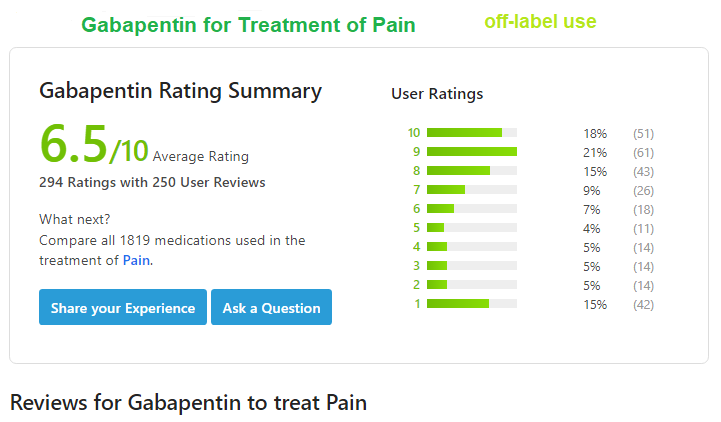What is gabapentin?
Gabapentin is a prescription drug. It comes as an oral capsule, an immediate-release oral tablet, an extended-release oral tablet, and an oral solution.
Gabapentin oral capsule is available as the brand-name drug Neurontin. It’s also available as a generic drug. Generic drugs usually cost less than the brand-name version. In some cases, the brand-name drug and the generic version may be available in different forms and strengths.
Why it’s used?
Gabapentin oral capsule is used to treat the following conditions:
- Seizures: Gabapentin is used to treat partial (focal) seizures. It’s taken together with other seizure medications in adults and in children 3 years of age and older who have epilepsy.
- Postherpetic neuralgia: This is pain from nerve damage caused by shingles, a painful rash that affects adults. Shingles appears after infection with the varicella zoster virus. This virus occurs in people who have had chicken pox.
Gabapentin may be used as part of a combination therapy. This means you may need to take it with other drugs.
How it works?
Gabapentin belongs to a class of drugs called anticonvulsants. A class of drugs is a group of medications that work in a similar way. These drugs are often used to treat similar conditions.
It’s not fully understood how gabapentin works. For postherpetic neuralgia, it seems to prevent the increase in sensitivity to pain that occurs. For seizures, it may alter the effect of calcium (low levels of calcium may cause seizures).
Gabapentin is off label used for treatment of nerve pain not all kinds of pains. 65% patients think it is effective for pain but as high as 35% think it doesnot work.
bubba smith Reviewed it very good for nerve pain:
“I have severe spine damage. t7 t8 and disc in between basically gone, nerve pain unbelievable. I tried lyrica in large dose and no relief.
Then one doctor said some meds don’t work on some but do on others you just have to get the correct one. So I tried gabapentin and to me it was a life saver, within 3 days the pain was gone or close to gone. 1800 mgs a day ( 6x300mg) plus 40 mg of oxyneo (4x10mg) which is oxycodone time release formula.
The pain specialist say maybe more dose needed but I can’t function properly. That is my minimum dose even drop 1 pill out of them amounts I can feel the difference in pain.
The side effects to me are , tiredness, constipation, memory, blurred vision, moody, seems heat and humid days if outside I get really disoriented so I stay inside”

But a Anonymous guy reviewed it not good for Knee Pain:
“My Husband was given this medication due to suffering long term knee pain. He took it for approx 6 weeks max and had to stop.
The most awful side effects you can imagine for the whole time blighted him. Maybe he was just unlucky and this med didn’t suit him but it’s Cons certainly outweighed its Pros in his case.
Weight gain Excess gas Dizzyness Nausea Vomiting Diarrhoea Headaches…… Not a good one for him at all. UK Based.”
Because I am a recovering alcoholic it is crucial for me to find non-narcotic treatment for the persevering pain of my chronic pancreatitis.
I was feeling a bit hopeless with the repeated prescriptions of pain meds (which of course offer only temporary relief, and for me a danger of over-use), until my GI prescribed me Gabapentin.
This med has been incredibly successful in mitigating my pain, while also giving me huge energy (I’m a consistent runner so this factor is welcomed), and allowing me to move forward with my sobriety.
I give it four stars, though I realize like anything, it’s not for everyone. That said, good luck to you all with finding what works.
Gabapentin is Widely Used for Pain Relief
Gabapentin is approved to treat the type of nerve pain (neuralgia) that results from nerve damage. Gabapentin is used to treat neuralgia caused by a herpes zoster viral infection, also known as shingles. This pain is called post-herpetic neuralgia (PHN), and it can be severe and chronic. Gabapentin is also used to treat pain from diabetic neuropathy, which happens when nerves in the feet damaged by diabetes cause chronic burning pain.
The exact way that gabapentin works to relieve pain is not known. It may change the way the body senses and reacts to pain. Gabapentin is used to manage long-term (chronic) pain, not to be taken for pain as needed. Chronic pain can interfere with sleep and work, and lead to depression.
Studies show that pain relief may start within one week and reach a maximum effect in about 4 weeks. It can take this long because gabapentin is usually started at a low dose and gradually increased over time until it works.
For treating neuralgia, gabapentin is often started at 300 mg per day and gradually raised by 300 mg per day. One 2017 review of 37 studies found that pain relief usually occurs at a dose of 1,200 mg or more.
The same review compared gabapentin to an inactive medicine (placebo) in almost 6,000 adults with chronic pain from PHN or diabetic neuropathy. Study participants were given either gabapentin or a placebo for 4 to at least 12 weeks. The results showed that 30-40% of people taking gabapentin were able to reduce their pain by half or more, compared to 10-20% of people taking the placebo.
Although some people may get significant relief, others may have side effects without relief of pain. More than half of people taking gabapentin did not get significant relief and had side effects from the drug.
According to the review, about 60% of people taking gabapentin had side effects, including:
- Dizziness
- Sleepiness
- Water retention (edema)
- Clumsiness while walking (ataxia)
It does not typically make pain worse: In trials comparing gabapentin side effects to placebo side effects, only 1% of people reported increased pain, and this was the same for gabapentin and placebo.
Once you find the dose that relieves neuralgia for you, it is important not to stop taking it suddenly. Stopping suddenly can lead to withdrawal symptoms such as:
- Anxiety
- Insomnia
- Nausea
- Pain
- Sweating
